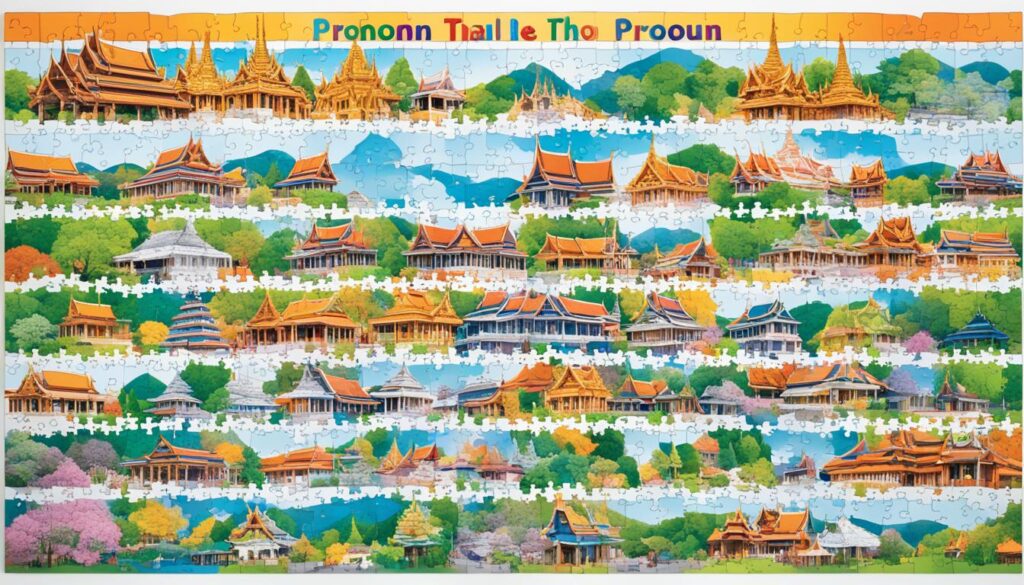Did you know that the Northern Thai Language, also known as Kam Mueang, is spoken by approximately six million people in Northern Thailand? This unique dialect, which is part of the rich Northern Thai culture, is also referred to as the Lanna language or the Chiang Mai dialect. As one of the fascinating Thai language variations, the Northern Thai Language showcases the linguistic diversity of Thailand. Let’s delve into the origins, phonological features, and grammar of this intriguing dialect to discover more about the captivating world of Northern Thai communication.
Origins and Classification
The Northern Thai language has its roots in the migration of Southwestern Tai-speaking people from southeastern China, specifically Guangxi and northern Vietnam. These migrants settled in what is now Northern Thailand and established early kingdoms such as Ngoenyang and Phayao. As a member of the Southwestern branch of the Tai language family, the Northern Thai language belongs to the larger Kra-Dai language family.
Linguistically, Northern Thai is classified as one of the Chiang Saen languages, along with Thai, Southern Thai, and other smaller languages. It has its own distinct characteristics and influences from neighboring languages, such as Central Thai and Lao.
In understanding the origins and classification of the Northern Thai language, it is clear that it has evolved as a result of historical migrations and linguistic influences.
Linguistic Influences
The Northern Thai language has been shaped by various linguistic influences over time. Its proximity to neighboring regions with different languages, such as Central Thai and Lao, has resulted in the adoption of words, expressions, and grammatical features from these languages. This linguistic interaction has enriched the vocabulary and grammar of Northern Thai, making it a unique and distinctive language within the Southwestern Tai group.
Additionally, the Northern Thai language has been influenced by other languages spoken in the region. The historical connections between Northern Thailand and the Kingdom of Chiang Saen have contributed to the linguistic similarities and shared features among the Chiang Saen languages.
Classification within the Tai Language Family
The Tai language family is a part of the larger Kra-Dai language family which includes several language branches. Within the Tai language family, the Northern Thai language belongs to the Southwestern branch along with other languages such as Thai, the official language of Thailand, and Southern Thai.
Table: Classification of Northern Thai within the Tai Language Family
| Language Family | Branch | Sub-Branch | Language |
|---|---|---|---|
| Kra-Dai | Tai | Southwestern | Northern Thai |
| Central | Thai | ||
| Southern | Southern Thai |
This classification highlights the close relationship between Northern Thai and other Tai languages, while also establishing its distinctiveness within the Southwestern branch.
The migration of Southwestern Tai-speaking people, the linguistic influences from neighboring languages, and the classification within the Tai language family all contribute to the unique origins and classification of the Northern Thai language.
Phonological Features and Differences from Central Thai
The Northern Thai language exhibits various phonological features and differences when compared to Central Thai. These distinctions contribute to the unique pronunciation and sound characteristics of Northern Thai. Some notable differences include:
- Substitution of “ch” with “j”: In Northern Thai, the initial “ch” sound found in Central Thai is replaced with the “j” sound. For example, the Central Thai word “chao” (to be delicious) is pronounced as “jao” in Northern Thai.
- Change of initial “r” to “h”: Northern Thai exhibits a shift from the initial “r” sound in Central Thai to the “h” sound. For instance, the Central Thai word “ruk” (love) becomes “huk” in Northern Thai.
- Shift of aspirated “ph” to unaspirated “p”: Another phonological difference is the shift of aspirated “ph” sounds in Central Thai to unaspirated “p” sounds in Northern Thai. As an example, the Central Thai word “phat” (to divide) is pronounced as “pat” in Northern Thai.
- Differences in tone: One of the significant distinctions between Northern Thai and Central Thai lies in tonal differences. While Central Thai has five tones, Northern Thai features six tones. These tonal variations contribute to the melodic and tonal characteristics that set Northern Thai apart.
These phonological differences play a crucial role in shaping the distinct pronunciation and sound patterns of Northern Thai. They provide a unique identity to the dialect and showcase the linguistic diversity present within the Thai language.

Example:
“Central Thai: chaja, Northern Thai: jaja”
“Central Thai: rak, Northern Thai: hak”
“Central Thai: phat, Northern Thai: pat”
Useful Words and Phrases in Northern Thai
Learning some basic words and phrases in Northern Thai can greatly enhance communication and cultural immersion when visiting Northern Thailand. Here are some essential Northern Thai phrases to help you get started:
Greetings
“SA-WAD-DEE-JAO” (Hello) and “KHOB-KHUN-JAO” (Thank you) are important phrases to know. These greetings will help you create a friendly impression and show respect to the locals.
Numbers
Knowing numbers can be particularly helpful, especially when using public transportation. Here’s the word for “20”: “SAAO”. Memorizing this number will facilitate your interactions and make navigating the region more convenient.
Directions
If you’re unsure how to get to a specific location, asking for directions in Northern Thai can be useful. Try saying: “PAI-TANG-DAI-JAO”, which translates to “How can I get to [name of location]?” Locals will appreciate your effort to communicate in their language.
Food-Related Phrases
When dining in Northern Thailand, ordering food in Northern Thai can add a personal touch and help you discover unique local dishes. To ask for a recommendation, say: “MEE-MENU-NAE-NUM-KOR-JAO”, which means “Can you recommend your menu specialty?”
Other useful words and expressions include compliments, requesting more of something, and polite expressions for apology and gratitude. Engaging with the locals using these phrases will not only enrich your cultural experience but also foster meaningful connections during your time in Northern Thailand.
| Phrases | Translation |
|---|---|
| SA-WAD-DEE-JAO | Hello |
| KHOB-KHUN-JAO | Thank you |
| SAAO | 20 |
| PAI-TANG-DAI-JAO | How can I get to [name of location]? |
| MEE-MENU-NAE-NUM-KOR-JAO | Can you recommend your menu specialty? |
Pronouns and Grammar in Northern Thai
In the Northern Thai language, pronouns play a crucial role in communication, reflecting both gender and formality levels. Unlike in Central Thai, Northern Thai has specific pronouns for different genders and societal hierarchies. Understanding these pronouns is vital for effective conversations and showcasing respect in Northern Thai society.
Gender-Specific Pronouns
One of the notable differences between Northern Thai and Central Thai is the use of gender-specific pronouns. Here are some examples:
| Gender | Pronoun |
|---|---|
| Male | Ai |
| Female | Pee |
For instance, when referring to a man, the pronoun “Ai” is used, while the pronoun “Pee” is used for women. This linguistic distinction emphasizes the cultural nuances and gender-specific language of Northern Thai.
Polite Particles
In addition to gender-specific pronouns, polite particles are essential in Northern Thai discourse to convey respect and politeness. These particles are used differently based on gender. For example:
| Gender | Polite Particle |
|---|---|
| Male | Xap |
| Female | Jao |
The polite particle “Xap” is used by men, while “Jao” is used by women. These particles are added to the end of sentences to express respect and maintain politeness in conversations.
Grammar Rules
The grammar rules in Northern Thai differ from those in Central Thai. They encompass word order, verb conjugation, and sentence structure. Here are some key grammar rules in Northern Thai:
- Word Order: The word order in Northern Thai is subject-verb-object (SVO), similar to English. For example, “I eat rice” in Northern Thai would be “Khaao phak khao”.
- Verb Conjugation: Verbs in Northern Thai have different forms depending on tense, aspect, and mood. Conjugation patterns vary based on the verb class.
- Sentence Structure: Northern Thai sentences often use classifiers to indicate specificity or generalization. These classifiers come after the noun they modify.
The grammar rules in Northern Thai reflect the language’s unique structure and contribute to its distinctive identity within the Thai language family.

Summary
In summary, the pronouns and grammar rules in Northern Thai serve as important elements of communication, showcasing the intricate gender-specific language and cultural traditions of Northern Thai society. By understanding and using these unique pronouns and adhering to the grammar rules, individuals can demonstrate respect and appreciation for the linguistic heritage of Northern Thailand.
Conclusion
The Northern Thai Language offers a unique opportunity for language learning and cultural immersion in Thailand. By studying and understanding this language, individuals can gain a deeper understanding of the rich linguistic diversity present in the country. The Northern Thai Language, with its distinct vocabulary, expressions, and grammar rules, reflects the unique cultural heritage of the Northern Thai people.
Learning Northern Thai not only enhances communication with locals in Northern Thailand but also allows for a more meaningful connection with the community. By speaking their language, one can engage in conversations, exchange ideas, and gain insights into the local customs, traditions, and way of life. Language learning is a gateway to cultural immersion, enabling individuals to appreciate and respect the rich cultural heritage of Northern Thailand.
Embracing linguistic diversity is vital for preserving and celebrating the Northern Thai culture. The Northern Thai Language, with its unique phonological features, useful words and phrases, and grammar rules, provides a fascinating subject of study. By learning this language, individuals can contribute to the preservation of the Northern Thai cultural identity and heritage, ensuring that it continues to thrive for future generations.
In conclusion, the Northern Thai Language offers an enriching and valuable language learning experience. It not only provides a means of communication but also serves as a gateway to understanding and appreciating the vibrant cultural heritage of Northern Thailand. By immersing oneself in the linguistic diversity of the region, one can truly embrace the beauty and richness of the Northern Thai culture.
